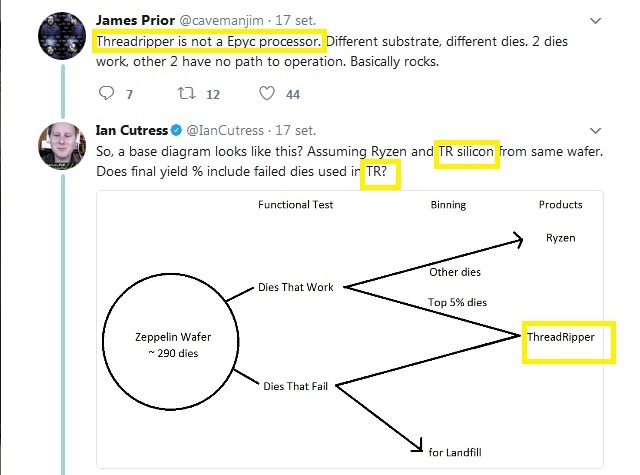juanrga :
As mentioned above, AMD said to the press that TR has only two dies:
That is the reason why the press published, then, that there are only two dies. der8hauer didn't trust AMD official statement and decided to test by himself if what AMD was saying the truth or was lying:
He found that AMD lied. There are four Zeppelin dies on ThreadRipper.
Charlie has changed the version. In his original post in the older thread "ThreadRipper is four dies (!), two dies are unused (?!?!)" he wrote that AMD said him that ThreadRipper has only two dies:
Now der8hauer has demonstrated that there are four dies, despite Charlie insults. I am still awaiting to Charlie to detail the packages differences.
AMD has clarified that two of the four silicon die are 'dummy' blanks rather than disabled Ryzen chips.
That is the reason why the press published, then, that there are only two dies. der8hauer didn't trust AMD official statement and decided to test by himself if what AMD was saying the truth or was lying:
How far would you go to prove a point? Well, the overclocker and CPU delidding expert der8auer has decided to put AMD's "Dummy Dies" claim to the test, to find out once and for all whether or not AMD is using failed/defective Ryzen dies or silicon spacers.
He found that AMD lied. There are four Zeppelin dies on ThreadRipper.
Charlie has changed the version. In his original post in the older thread "ThreadRipper is four dies (!), two dies are unused (?!?!)" he wrote that AMD said him that ThreadRipper has only two dies:
There are only 2 dies and the package is electrically different from Naples/Epyc, it isn't a salvage part. I will write it up in a bit but the 'rumors' are BS and based on both ignorance and, well, not asking the source.
-Charlie
Now der8hauer has demonstrated that there are four dies, despite Charlie insults. I am still awaiting to Charlie to detail the packages differences.
As usual you are starting to rewrite history and invent words that AMD never said. Actually you are unable to link to any official statements from AMD on the issue, because there are none. As the quote from charlie there is no reference to AMD, you invented that part. Anybody except you of course understands what he meant: "There are only 2 (working) dies and the package is electrically different from Naples/Epyc, it isn't a salvage part." The same sources you cite say:
The Dummy Story
Where did the dummy story come from? Well, according to Guru3D, it came from AMD itself:
“When we asked AMD about this at a recent summit they claimed that Threadripper has two working dies and two dummies to get you to the 16-cores. The two dummies would be in place for better structural support.“
Many other outlets reported the same story.
And as the source of the story says:
Nobody should really care about all this as it is just not relevant.
I'll will follow their advice. I don't care what you think, and nobody else does actually, as it's totally irrelevant.
As of Charlie's answer, you may await forever as i suspect he is not going to answer you. The answer is obvious, and you would know it by yourself if you werent totally obsesed and ofuscated in proving a point that nobody cares. I'm afraid that he is actually speaking the truth and not insulting.





